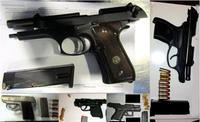-
Flight attendants not invited to Hill hearings on airplane security
The House Transportation Security Subcommittee has scheduled an upcoming hearing on Thursday titled “TSA’s Efforts to Advance Risk-Based Security: Stakeholder Perspectives,” but the hearing will not include a representative of America’s flight attendants. This omission has upset the Coalition of Flight Attendant Unions.
-
-
FAA fines NYC airports for using untrained personnel for fire, emergency duties
The Federal Aviation Administration (FAA) fined LaGuardia, Newark, and John F. Kennedy airports $3.5 million dollars for failing to train firefighters and aircraft-rescue personnel.
-
-
Lawmaker wants the FAA to keep Midway control tower operating
Representative Dan Lipinski (D-Illinois) is not happy with the Federal Aviation Administration’s (FAA) decision to add Midway Airport to the list of air ports whose air-traffic control towers are subject to closing during overnight hours because of the federal budget cuts.
-
-
New Airport security system to help special needs travelers
The Transportation Security Administration is training some of its employees to act as Passenger Support Specialists in order to help the disabled, people with medical condition, and people who are traveling with small children through the security process.
-
-
A more powerful terahertz imaging system developed
Low-energy terahertz radiation could potentially enable doctors to see deep into tissues without the damaging effects of X-rays, or allow security guards to identify chemicals in a package without opening it. An electrical engineering research team has developed a laser-powered terahertz source and detector system which transmits with fifty times more power and receives with thirty times more sensitivity than existing technologies. This offers 1,500 times more powerful systems for imaging and sensing applications.
-
-
Budget cuts force the FAA to shut down 149 control towers
The FFA will have to cut $637 million before 30 September. It plans to do so by give 47,000 employees two week furloughs, shutting down 149 control towers, and cutting overnight shifts at seventy-two different traffic facilities. Some worry about the impact these measures will have on air travel safety.
-
-
Lawmakers call on TSA to reverse knife rule
Two leading lawmakers have called on TSA to reverse its ruling which would allow passengers to bring some types of knives with them on board. “The attacks on September 11, 2001, demonstrated that in the confined environment of an airplane, even a small blade in the hands of a terrorist can lead to disaster,” Rep. Ed Markey (S-Mass.) — who is running for the U.S. Senate seat recently vacated by John Kerry – wrote TSA director John Pistole.
-
-
Airports yet to be affected by sequestration-related cuts
Since sequestration went into effect last Friday, both airport authorities and DHS have been saying that that passengers should prepare themselves for longer wait times at security checkpoints. So far, airports in major cities have reported no discernible increase in wait time at security lines.
-
-
TSA would allow knives on planes beginning 25 April
The Transportation Security Administration (TSA) yesterday announced that, starting 25 April, the prohibition against carrying knives on board would be lifted. TSA would also allow other items banned since 9/11, such as lacrosse sticks, ski poles, and small, souvenir baseball bats. The flight attendants union was quick to condemn to move, calling the decision “dangerous” and “designed to make the lives of TSA staff easier, but not make flights safer.”
-
-
FAA investigates on-board dance
Last month the Colorado College ultimate frisbee team, along with other passengers, took part in a YouTube sensation known as the Harlem Shake during a packed flight on Frontier Airlines from Colorado Springs to San Diego. The FAA is now investigating whether safety regulations were violated.
-
-
Increasing the sensitivity of airport security screening
The latest episode in the American Chemical Society’s (ACS) Global Challenges/Chemistry Solutions podcast series reports a simple way to improve the sensitivity of the test often used to detect traces of explosives on the hands, carry-ons, and other possessions of passengers at airport security screening stations.
-
-
Revealing full-body scanners to be removed from airports
One of the more controversial post-9/11 security devices, the ubiquitous and uncomfortably intrusive full-body scanners, will be removed from service by the Transportation Security Administration (TSA). On Friday, the agency announced it would begin to remove the scanners from U.S. airports this summer. The anatomically revealing backscatter scanners are being replaced by the ore discreet millimeter wave devices.
-
-
TSA hits new record in gun collection at airports in 2012

The Transportation Security Administration (TSA) set a new record by confiscating 1,500 weapons in 2012, with 1,295 of the weapons being loaded; most of the confiscated weapons at airports are guns, but TSA has also caught passengers trying to board planes with grenades, stun guns, axes, and throwing stars; one passenger tried to board a plane carrying a bazooka, and another passenger was trying to bring a rocket launcher on board
-
-
Experts warn of growing threat to aviation: pilot fatigue

Safety expert criticizes EU proposals to relax flight-time limits; his study of pilots’ work found that over 20 percent of them said that by the time they completed their shift, they had been awake for twenty-eight hours or more
-
-
GPS technology helps track, monitor airfield anomalies
When we hear the term “airfield anomalies,” we may think of something serious such as a fire on a runway or a terrorist plot’ most of the time, however, the term could mean something as minor as birds on the runway; a new reporting system makes it easier to track and record such anomalies
-
More headlines
The long view
New Technology is Keeping the Skies Safe
DHS S&T Baggage, Cargo, and People Screening (BCP) Program develops state-of-the-art screening solutions to help secure airspace, communities, and borders
